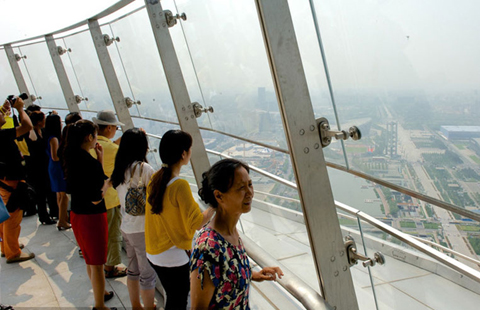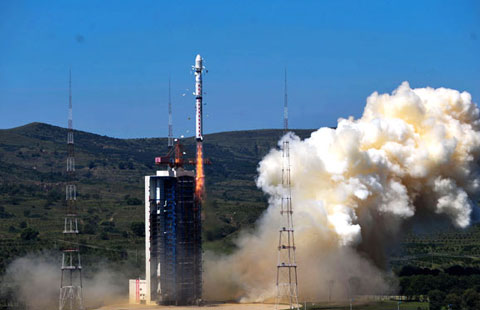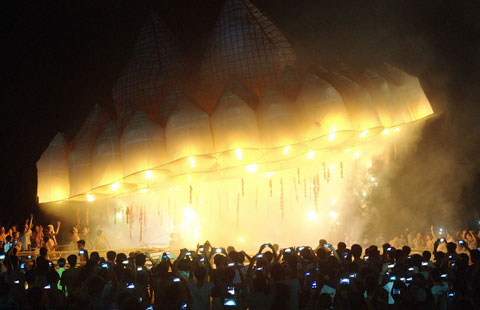Shanghai Tower reaches for sky and record
Updated: 2014-10-03 08:05
By Wu Yiyao(China Daily USA)
|
||||||||
Skyscrapers have been sprouting up around China in recent years on an unprecedented scale with more in the making, and the country is expected to host six of the world's 10 tallest buildings by 2020, reports Wu Yiyao in Shanghai.
The 632-meter Shanghai Tower will become China's tallest building and the world's second-tallest after the 828-meter Burj Khalifa Tower in Dubai.
Located in Lujiazui, Shanghai's financial zone, the skyscraper, to be completed in 2015, will not hold the title for long.
Zhongnan Center, in Suzhou in Jiangsu province, is planned to be more than 700 meters high, according to the city's urban planning department.
In Wuhan, capital city of Hubei province in Central China, a 1,000-meter-tall twin tower has been designed and, if approved by the government, will be erected in 2018.
"There is no end to the competition for the tallest building. For many developers and investors, it is a game of the taller the better," said Zhang Yuanzhi, project agent in Shanghai." A tall building embodies power - both architectural and financial."
Skyscrapers have been sprouting up around China in recent years on an unprecedented scale.
By 2020, China should have six of the world's top 10 skyscrapers, according to the Chicago-based Council on Tall Buildings and Urban Habitat, a nonprofit organization that focuses on the planning, design, construction and operation of tall buildings.
China will dominate global super-tall building development in the next five years. Its number of such buildings - more than 200 meters high and with more than 40 stories - will account for 70 percent of world's total, according to a report by realty service provider CBRE Inc.
CBRE said about 51 percent of China's super-tall buildings are in second-tier cities, including Shenyang in Liaoning province and the municipalities of Chongqing and Tianjin.
Antony Wood, executive director of the Council on Tall Buildings and Urban Habitat, said skyscrapers reflect a city's aspiration and competence.
"If you look at the names of the towers, you'd see the changes," said Wood.
In the past, a tower was usually named after an enterprise such as the Rockefeller Center in New York or Jin Mao Tower in Shanghai. Now they are called Shanghai Tower, Wuhan Center and Canton Tower, said Wood.
However, some analysts and market insiders have expressed concerns about an oversupply of such tall buildings in some metropolises, especially those cities with less experience of managing such buildings.
"Some second- or lower-tier cities face risks of an oversupply," said Frank Chen, head of China research at CBRE.
He noted some cities are only regional centers and do not have much appeal to attract tenants.
Andy To, executive director of asset services at CBRE China, said many of the developers in emerging markets believe that once the super-tall buildings are built, tenants will eventually come but in many cases it does not turn out to be the case.
The many aspects of a city's condition - business environment, tax rates, market transparency, government efficiency, infrastructure, communications and human resources - are all important factors in an authority deciding whether the city needs many tall buildings, said To.
Sophie Lo, a department director at a company in one of the super-tall buildings in Lujiazui, said she likes to work in such a place.
"The prestigious location indeed helps the business as people believe that a company that can pay rents usually 30 percent higher than other office buildings must be financially secure," said Lo.
Li Zhijie, who works on the 40th floor of a building that used to be one of the tallest buildings in the Lujiazui area decades ago, sees some disadvantages.
"The bad thing is that you feel isolated working in a tall building," said Li. "Dining in the neighborhood is often quite expensive. The cost of being in a prestigious location is not low."
Contact the writer at wuyiyao@chinadaily.com.cn
|
The 632-meter Shanghai Tower (right), located in Lujiazui, Shanghai's financial zone, is scheduled for completion in 2015. It is the second-tallest building in the world. Yan Daming / For China Daily |
|
A night view of Lujiazui, the financial district in Shanghai. China will have six of the world's top 10 skyscrapers by 2020, according to the Council on Tall Buildings and Urban Habitat. Lai Xinlin / For China Daily |
|
A general view from Victoria Peak in Hong Kong. In the city, many tall office buildings are connected by overpasses, a form that future cities may take. Edmond Tang / China Daily |

(China Daily USA 10/03/2014 page14)

 Visitors trade cash for luck at World Heritage site
Visitors trade cash for luck at World Heritage site Sharapova beats Kvitova to win China Open
Sharapova beats Kvitova to win China Open
 China-Mexico ties deepen
China-Mexico ties deepen
 58 couples say 'I do' among the clouds
58 couples say 'I do' among the clouds
 Chinese convoy fleet executes escort missions in Gulf of Aden
Chinese convoy fleet executes escort missions in Gulf of Aden
 Chinese FM Wang Yi meets with Mexican president
Chinese FM Wang Yi meets with Mexican president
 China leads medal table as Asian Games close
China leads medal table as Asian Games close
 Highlights at Paris auto show
Highlights at Paris auto show
Most Viewed
Editor's Picks

|

|

|

|

|

|
Today's Top News
HK officials resume work as protests thin
Brazil's Rousseff to face Neves in rival in runoff
Some protesters in HK decide to withdraw
China startups 'get smart' about healthcare devices
US, India stir S. China Sea debate
Brazilians more aware of breast cancer symptoms, survey finds
Ebola patient in Dallas struggling to survive, says CDC head
Ebola could reach France and UK
US Weekly

|

|










